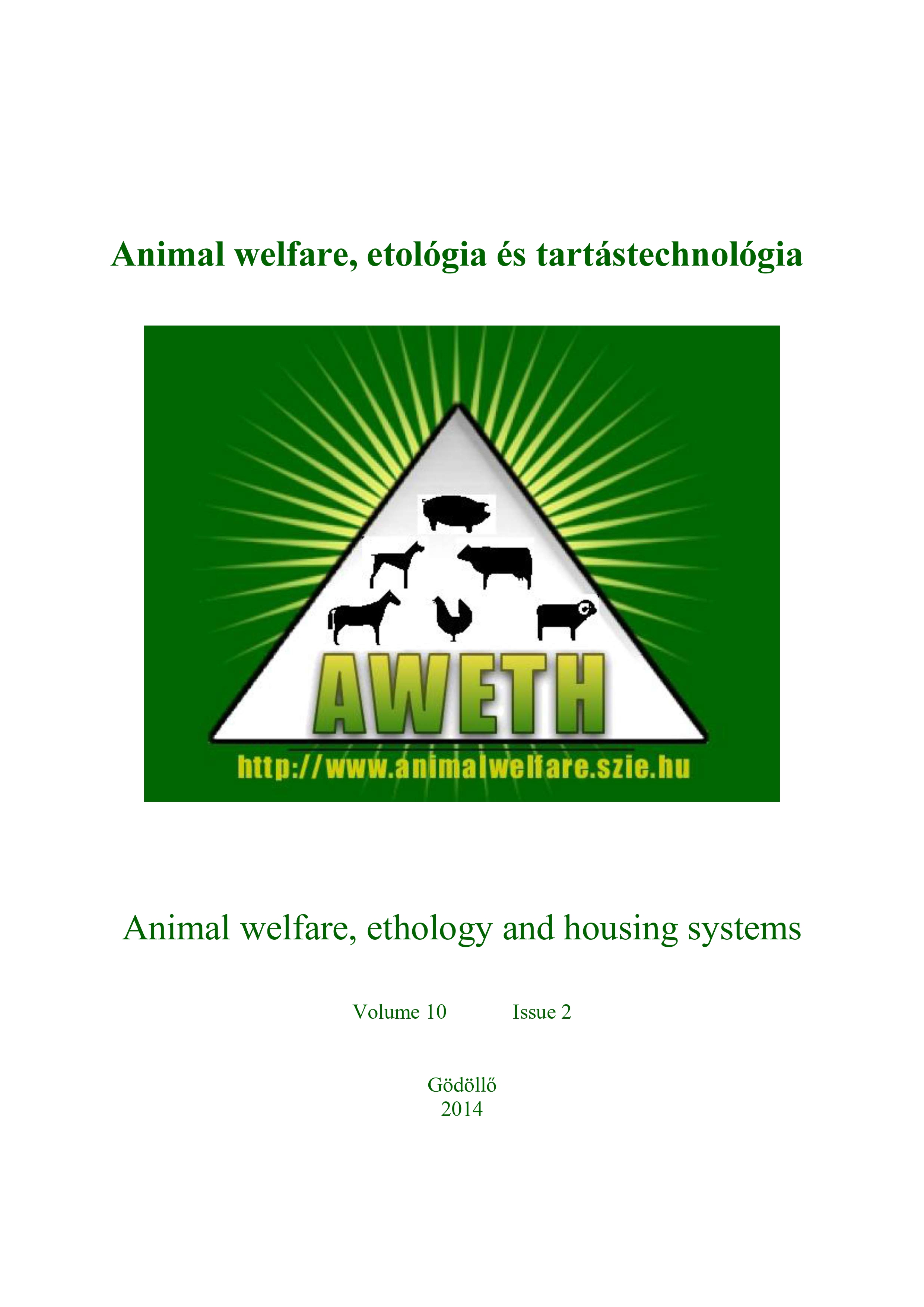Mikroalga alapú takarmánykiegészítők alkalmazási lehetőségeinek feltérképezése
Irodalmi áttekintés
Schlagwörter:
mikroalga, takarmánykiegészítő, kémiai összetételAbstract
Földünk népessége nő és ez magával hozza az élelmiszerek iránti egyre fokozottabb igényt. Ennek megoldása létfontosságúvá válik, amellett, hogy ezt fenntartható módon kell kiviteleznünk. Megoldást jelenthet, ha visszanyúlunk egy régi táplálékhoz, vagy ha melléktermékeket próbálunk hasznosítani, takarmányozási célra. Az algákban számos létfontosságú anyag található, így érthető az algák kedvező biológiai hatása. Kémiai összetételük ismeretes, bár élettani folyamatokban betöltött szerepük még nem teljesen tisztázott. A gazdasági állatok takarmányához hozzáadott mikroalga erősíti az immunrendszert, csökkenti a koleszterol mennyiséget, antikarcinogén hatású, védelmet nyújt a toxikózisokkal szemben. Az algaliszt javítja az állatok egészségi állapotát, növeli a súlygyarapodást, javítja a takarmányértékesítő képességet, illetve kedvező hatást gyakorol a szaporasági mutatókra. Számos hatásuk ellenére a mikroalgák területe még nem egészen feltérképezett. 10000 faj létezését feltételezik, de csak néhány ezerből tartanak fent tenyészetet és csak néhány száznak ismertük meg a kémiai összetételét.
Literaturhinweise
Az 1275/2013/EU RENDELETE (2013. december 6.) 2002/32/EK európai parlamenti és tanácsi irányelv I. mellékletének az arzén, a kadmium, az ólom, a nitritek, az illékony mustárolaj és a káros botanikai szennyeződések maximális szintje tekintetében történő módosításáról.
Abril, R., Garrett, J., Zeller, S. G., Sander, W. J., Mast, R. W. (2003): Safety Assessment of DHA-rich microalgae from Schizochytrium sp. Part V: target animal safety/ toxicity study in growing swine. Regulatory Toxicology and Pharmacology, 37(1) 73–82. https://doi.org/10.1016/S0273-2300(02)00030-2
Ali, M. A., Leeson, S. (1995): The nutritive value of some indigenous Asian poultry feed ingredients. Animal Feed Science Technology, 55(3–4) 227-237. https://doi.org/10.1016/0377-8401(95)00801-S
Bai, A. (2013): Sertés-hígtrágyára alapozott kapcsolt energia- és takarmány-előállítás. Journal of Central European Green Innovation, 1(1) 11–20.
Becker, E.W. (2004): Microalgae in human and animal nutrition. In: Richmond A. (ed) Handbook of Microalgae Culture. Biotechnology and Applied Phycology. Oxford: Blackwell Science. pp. 461–503. https://doi.org/10.1002/9780470995280.ch18
Belay, A., Kato, T., Ota, Y. (1996): Spirulina (Arthrospira): potential application as an animal feed supplement. Journal of Applied Phycology, 8. 303–311. https://doi.org/10.1007/BF02178573
Bennedsen, M, Wang, X, Willén, R, Wadström, T, Andersen, L. P. (1999): Treatment of H. pylori infected mice with antioxidant astaxanthin reduces gastric inflammation, bacterial load and modulates cytokine release by splenocytes. Immunol Lett., 70(3) 185–189. https://doi.org/10.1016/S0165-2478(99)00145-5
Da Silva, R. L., Barbosa, J. M. (2008): Seaweed meal as a protein source for the white shrimp Lipopenaeus vannamei. Journal of Applied Phycology, 21(2) 193–197. https://doi.org/10.1007/s10811-008-9350-4
Dhargalkar, V.K., Verlecar, X.N. (2009): Southern ocean seaweeds: a resource for exploration in food and drugs. Aquaculture, 287(3–4) 229–242. https://doi.org/10.1016/j.aquaculture.2008.11.013
Ginzberg, A., Cohen, M., Sod-Mariah, U.A., Shany, S., Rosenshtrauch, A., Arad, S. (2000): Chickens fed with biomass of the red microalga Porphyridium sp. have reduced blood cholesterol level and modified fatty acid composition in egg yolk. Journal of Applied Phycology, 12(3) 325–330. https://doi.org/10.1023/A:1008102622276
Grinstead, G. S., Tokach, M. D., Dritz, S. S., Goodband, R. D, Nelssen, J. L. (2000): Effects of Spirulina platensis on growth performance of weanling pigs. Animal Feed Science and Technology, 83(3–4) 237–247. https://doi.org/10.1016/S0377-8401(99)00130-3
Hassan, A. M., Abdel-Aziem, S. H., Abdel-Wahhab, M. A. (2012): Molulation of DNA damage and alteration of gene expression during aflatoxicosis via dietary supplementation of Spirulina (Arthrospira) and whey protein concentrate. Exotoxicology and Environmental Safety, 79. 294–300. https://doi.org/10.1016/j.ecoenv.2012.01.017
Latcscha, T. (1990): Carotenoids in Animal Nutrition. Hoffman-La Roche Ltd., Basel, Switzerland, ISBN 3-906507-03-3.
Mordenti, A. L., Sardi, L., Bonaldo, A., Pizzamiglio, V., Brogna, N., Cipollini, I., Tassinari, M., Zaghini, G. (2010): Influence of marine algae (Schizochytrium spp.) dietary supplementation on doe performance and progeny meat quality. Livestock Science, 128(1–3) 179–184. https://doi.org/10.1016/j.livsci.2009.12.003
Muller-Feuga A. (2004): Microalgae for aquaculture. The current global situation and future trends. In Richmond, A. (ed). Handbook of microalgae culture. Blackwell, Oxford. pp. 352–364. https://doi.org/10.1002/9780470995280.ch19
Peiretti, P. G., Meineri, G. (2008): Effects of diets with increasing levels of Spirulina platensis on the performance and apparent digestibility in growth rabbits. Livestock Science, 118(1–2) 173–177. https://doi.org/10.1016/j.livsci.2008.04.017
Piccardi, R., Materassi, R., Tredici, M. (1999): Algae and human affairs in the 21st century. (Abstr Int Conf Appl Algol) Universita degli Studi di Firenze, Firenze.
Pulz, O., Gross, W. (2004): Valuable products from biotechnology of microalgae. Appl. Microbiol Biotechnol, 65(6) 635–648. https://doi.org/10.1007/s00253-004-1647-x
Sardi, L., Martelli, G., Lambertini, L., Parisini, P., Mordenti, A. (2006): Effects of a dietary supplement of DHA-rich marine algae on Italian heavy pig production parameters. Livestock Science, 103(1–2) 95–103. https://doi.org/10.1016/j.livsci.2006.01.009
Schreckenbach, K., Thürmer, C., Loest, K., Träger, G., Hahlweg, R. (2001): Der Einfluss von Mikroalgen (Spirulina platensis) in Trockenmischfutter auf Karpfen (Cyprinus carpio). Fischer Teichwirt, 1. 10–13.
Spolaore, P., Joannis-Cassan, C., Duran, E., Isambert, A. (2006): Commercial applications of microalgae. Journal of Bioscience and Bioengineering, 101(2) 87–96. https://doi.org/10.1263/jbb.101.87
Thajuddin, N., Subramanian, G. (2005): Cyanobacterial biodiversity and potential applications in biotechnology. Current Science, 89(1) 47–57.
Vincze, L. (2012): Mikro alga: a jövő takarmánya? Magyar Állattenyésztők Lapja, 17(12) 24–25.
Waldenstedt, L., Inborr, J., Hansson, I., Elwinger, K. (2003): Effects of astaxanthin-rich algal meal (Haematococcus pluvalis) on growth performance, caecal campylobacter and clostridial counts and tissue astaxanthin concentration of broiler chickens. Animal Feed Science and Technology, 108(1–4) 119–132. https://doi.org/10.1016/S0377-8401(03)00164-0
Wang, X., Willén, R., Wadström, T. (2000): Astaxanthin-Rich Algal Meal and Vitamin C Inhibit Helicobacter pylori Infection in BALB/cA Mice. Antimicrobial Agents and Chemotherapy, 44(9) 2452–2457. https://doi.org/10.1128/AAC.44.9.2452-2457.2000
Yamaguchi, K. (1997): Recent advances in microalgal bioscience in Japan, with special reference to utilization of biomass and metabolites: a review. Journal of Applied Phycology, 8(6) 487–502. https://doi.org/10.1007/BF02186327
Internetes források
Bai, A., Vaszkó, G., Csányi, F., Tőzsér, B. (2012) Algák: mikroméretben hatalmas lehetőségek? 2012. november http://www.innoteka.hu/cikk/algak_mikromeretben_hatalmas_ lehetosegek.542.html
http1: http://algainfo.mindenkilapja.hu/
http2: http://www.tankonyvtar.hu/hu/tartalom/tkt/fermentacios/ch03s02.html
http3: http://www.ncbi.nlm.nih.gov/pmc/articles/PMC3881014/
http4: http://wellstarsiker.hu/mikroalgak.html
http5: http://www.weborvos.hu/egeszsegmagazin/mikroalga_fiatalsag_titka/160531/
http6: http://www.spirulina-mikroalga.hu/newsitem-hu-34-tobbet_a__spirulina_algarol
http7: http://www.mikroalga_gyogyaszat.abbcenter.com/?m=mikroalgak
http://www.ncbi.nlm.nih.gov/pmc/articles/PMC3881014/
http://www.tankonyvtar.hu/hu/tartalom/tkt/fermentacios/ch03s02.html
Downloads
Veröffentlicht
Ausgabe
Rubrik
Lizenz
Copyright (c) 2014 Szabó Rubina Tünde, Bodnár Ákos, Pajor Ferenc, Póti Péter, Weber Mária

Dieses Werk steht unter der Lizenz Creative Commons Namensnennung - Nicht-kommerziell - Keine Bearbeitungen 4.0 International.
A folyóirat a nyílt hozzáférés elvei szerint működik, cikkeire ugyanakkor a Creative Commons 4.0 standard licenc alábbi típusa vonatkozik: CC-BY-NC-ND-4.0. Ennek értelmében a mű szabadon másolható, terjeszthető, bemutatható és előadható, azonban nem használható fel kereskedelmi célokra (NC), továbbá nem módosítható és nem készíthető belőle átdolgozás, származékos mű (ND). A licenc alapján a szerző vagy a jogosult által meghatározott módon fel kell tüntetni a szerző nevét és a szerzői mű címét (BY).














